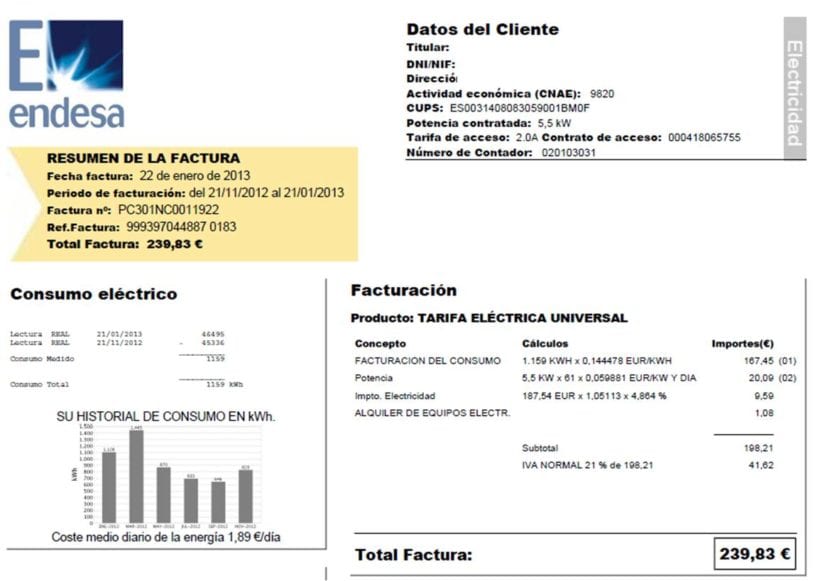
The electricity bill is one of the most hated by the Spanish, and it is no wonder: we have years of continuous increases in the price of electricity. Some media have assured that represents 40% of the income of many households with at least one member unemployed.
And it is that knowing when electricity is cheaper, is no longer a thrifty obsession, but a necessity, regardless of the amount of money that enters your bank account each month, or the amount that you do not enter.
In this article we will try to help you discover when is the light cheaper, but also understand why it is so difficult to know, so much so that, sometimes, not even the technicians of the different electricity companies know it for sure.
The challenge of understanding the electricity bill
It does not matter if you electric power contract You have it with Iberdrola, Endesa, or any other: understanding the electricity bill is a challenge. So, when your bill comes home, and you don't understand it, it's not your problem, we all have that problem.
Understanding the electricity bill is key to later understanding how the price is calculated, and when the electricity is cheapest.

Okay, let's get to it.
We recommend that you have your invoice and compare or underline the data that we mention in order to make it much easier for you.
- General data
Data of the contract holder, such as name, DNI or NIE address, contract number, invoice number, billing period, etc.
- Rate type of your contract
By the name of the company you will be able to know the type of rate that you have in force in your contract, if it does not tell you later: Voluntary Price for Small Consumer (PVPC) or free market. PVPC is offered by: Hidrocantábrico Energía Último Recurso, Iberdrola Comercialización de Último Recurso SAU, Endesa Energía XXI SLU, Unión Fenosa Metra SL and E.ON Comercializadora de Último Recurso.
- Invoice summary
You will see a small summary of how the total of your electricity bill was calculated. You will see a small breakdown of how it has been billed, seeing your consumption, the price per kilowatt and other elements.
- Electricity consumption report
You will now see a complete breakdown of your consumption, rates, commissions, contracted services, a consumption history, in which some companies calculate your daily consumption in the form of money. You can compare the consumption of the current exercise with the same of the previous year.
- Contract details
Here you will see well all the data of your contract, such as, for example, knowing if you have the fixed rate, by hourly discrimination, the telephone number for technical service, or if you already have the 'smart' meter (yes, in quotation marks), the number of CUPS to see your consumption on the internet in real time.
- Other data
The other data that appears is merely informative, such as the consumption graph, company notices, advertising, or whatever the company deems appropriate.
How your invoice is calculated
You should see, first of all, on your bill, the contracted power and the type of billing or tariff you have, in addition to the contracted power, which is the number of kilowatts contracted to your operator, is the same as the megawatts of your mobile data rate, and it depends on how many devices you can turn on in your home. The power can be 3300w, 4400w, 5500w or 8000w.

The calculation of the price of your electric power is calculated by multiplying:
- The contracted power (in kW)
- Period, monthly, bimonthly or daily, it depends on your company
- Government Canon
The canon is what the government controls to raise or lower the price of the electricity bill, although companies can also apply offers in this area to make their rates more attractive.
Besides that, a variable rate is paid, which is the payment for the energy consumed, or called energy billed, is calculated by multiplying:
- The energy consumed in the billing period (kW per hour)
- Kilowatt hour price
You will add these two amounts, and you will add fees such as equipment rental, 21% VAT and 5% Electricity Tax.
How is the variable part of the invoice calculated?
As of October last year, the price per kilowatt hour changes, And it no longer works as before, that an electricity auction was held every quarter, and it was the one that was used to calculate the rate, with the previous calculation. Now the kilowatt rate is done in a wholesale market with an hourly price, and only one day in advance, that is, there will be 24 different kilowatt hour rates instead of one.
Does it affect you? If you have a regulated rate, the one previously called TUR, now PVCP, yes, because you will have to pay attention to the price per kilowatt hour. If you are in the free market, no, but you will lose the reference to whether you pay a lot or a little.
To fix, with this new method, the price, an estimate is made of the amount of electricity that will be consumed the next day
A forecast is made of how much electricity will be consumed in each of the hours of the next day. The price is covered under an auction, and the price changes according to the hour, that is, if there is an hour with more consumption, there will be more bids, and its price will be higher, than that of an hour with little consumption, which will be cheaper.
For all this, it is key the 'smart' counter, which measures hourly consumption, but if they do not have it, companies apply a standard consumption profile, and it will not matter what you consume at any time, as it is in the largest number of households in Spain.
When is light cheaper
Having already understood the bill and how electricity is calculated, we have to talk about when electricity is cheapest.
The best way, if you have an hourly rate, is to go to the page of the Red Eléctrica de España, where they publish daily the prices per kilowatt of the following day, starting at 20:30 p.m.

Normally, these are the key hours you should know, although they vary depending on whether it is a vacation period, or a weekend:
- The most expensive time is from 21:22 p.m. to XNUMX:XNUMX p.m.
- The optimal time is 7 to 8 hours
- The cheapest hour is 2 to 3 hours
For example, at the time of writing this article, the consumption of each of the previous hours is:
- The most expensive hour costs € 0,11 per kilowatt
- The optimal hour is priced at € 0,09 kWh
- The cheapest hour costs € 0,08 kWh
Thus, you can program the switching on of the appliances that consume the most in your home, such as the washing machine, the ceramic hob, in winter, the heating, or in summer the air conditioning, etc.
Although at a general level, morning and night hours are the most expensive, that is, and the cheapest are the early morning hours, from two in the morning.
There will be days when the most expensive hour is even more than double the cheapest hour, especially in summer and winter.
If you have the time and patience to schedule your consumption on a daily basis, this system is convenient for you, since you will see the consumption of the bill reduced, which, in this case, is no longer bimonthly, but monthly.
The main disadvantage is that you will not be able to know for sure if the calculation of your invoice is correct or not. It is the same method that we have told you before, but calculated for each hour of each invoiced period, that is, 1440 calculations in a bimonthly invoice. A real madness that not even Excel can free you from.
The best solution: a tariff with hourly discrimination
If you want to save money, and forget about planning each schedule in your home, the best solution is a hourly discrimination rate.
It means divide the day into two hours, that is, peak hours (daytime) and off-peak hours (night).
Although it has also changed, the method is almost identical to the one before October 2015: the off-peak hour rate is much lower than the peak hour rate, and it depends on each company. Normally the off-peak rate is 50% cheaper than in peak hours.
Off-peak hours go from 23pm to 13pm in summer, and from 22pm to 12pm in winter.
Peak hours are from 13:23 p.m. to 12:22 p.m. in summer, and from XNUMX:XNUMX p.m. to XNUMX:XNUMX p.m. in winter.
Of course, off-peak hours will not always be cheaper than peak hours, but in general, this is the case.
With hourly discrimination, it eliminates uncertainty, and it is only convenient if your consumption is approximately 30% higher, at least, at night than daily, and that daytime consumption can be controlled to the maximum.
If you are not able to control consumption, it is best that you stay in the standard rate, and that you check the consumption daily in order to know the best time to turn on the washing machine, air conditioning or heating.
To know when electricity is cheapest, in short, it is necessary to know what rate you have contracted, what billing method, and check the price per kilowatt hour daily, although it will always be at dawn.
We hope that, with all this guide, you will have less fear when the next bill for your electricity consumption comes home, and that it will be much lower than the previous period. If you have any doubts, we recommend you compare with other companies, rates or forms of consumption, contrary to what is thought, there are many offers and rates.
Great article without a doubt. In the end, having to look at this kind of thing for everyone is still a disorder with what many people "go through" and keep putting their appliances when they want / can. There are tools that do this job for you.